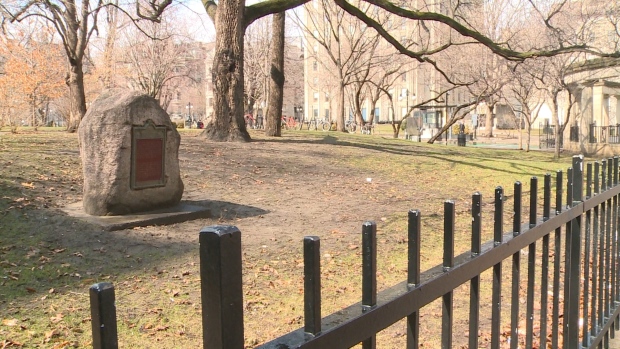[timeline_excerpt]Hochelaga was an Iroquois village, likely situated near where McGill campus is today, documented by Jacque Cartier on his voyage to Canada in 1535 but found abandoned in a subsequent French expedition in 1600 (see 1553 entry above for more information). The site of Hochelaga was designated a national historic site by the Advisory Board for Historic Site Preservation in 1920. In 1925, a memorial stone referred to as the Hochelaga Rock, a remnant of Hochelaga, was laid on the lower field of McGill to commemorate the village.[/timeline_excerpt]
[timeline_content]
Hochelaga was an Iroquois village, likely situated near where McGill campus is today, documented by Jacque Cartier on his voyage to Canada in 1535 but found abandoned in a subsequent French expedition in 1600 (see 1553 entry above for more information). The site of Hochelaga was designated a national historic site by the Advisory Board for Historic Site Preservation in 1920. In 1925, a memorial stone referred to as the Hochelaga Rock, a remnant of Hochelaga, was laid on the lower field of McGill to commemorate the village. The plaque on the monument states:
“Near here was the site of the fortified town of Hochelaga visited by Jacques Cartier, in 1535, abandoned before 1600. It contained fifty large houses, each lodging several families, who subsisted by cultivation and fishing.”
Writer and comedian Stephen Leacock was asked to speak at the monument’s unveiling ceremony because he had published The Mariner of St Malo, a book about Cartier’s voyages, ten years earlier. In this book however Leacock disparages every act of kindness Hochelaga’s residents are said to have done for Cartier. He frames their offering gifts, providing practical advice, and caring for tired sailors as acts of submission to European supremacy. During the ceremony, Leacock explained that the scale of Hochelaga described by Cartier was impossible and beyond the capacity of the Iroquois, concluding: “Hochelaga is like the farmer’s giraffe. No such animal.” Leacock’s speech clearly revealed that he had not studied Cartier’s account and was misinformed in even the most basic facts, picturing log cabins instead of Iroquoian bark-covered longhouses.
The relocation of the monument from its little known place on campus to a more visible location across from the James McGill statue was first proposed to the administration by student leaders, faculty, and concerned community members. Initially their request was rejected due to reasons like insufficient funds, Parks Canada regulations, and concerns over the monument being “too visible” if it were across from the James McGill statue. Finally in 2016, former McGill professor Michael Loft contacted provost Christopher Manfredi about moving the rock in the wake of the Truth and Reconciliation Commission recommendations that suggested increasing Indigenous presence at educational institutions. The rock was moved over the summer and commemorated with a ceremony featuring McGill administration and Indigenous community leaders. This move coincides with the launch of McGill’s task force on Indigenous education and Indigenous studies, which works on attracting Onkwehón:we students from across Quebec to the university and increasing Indigenous faculty, presence, space and support throughout the university.[/timeline_content]

